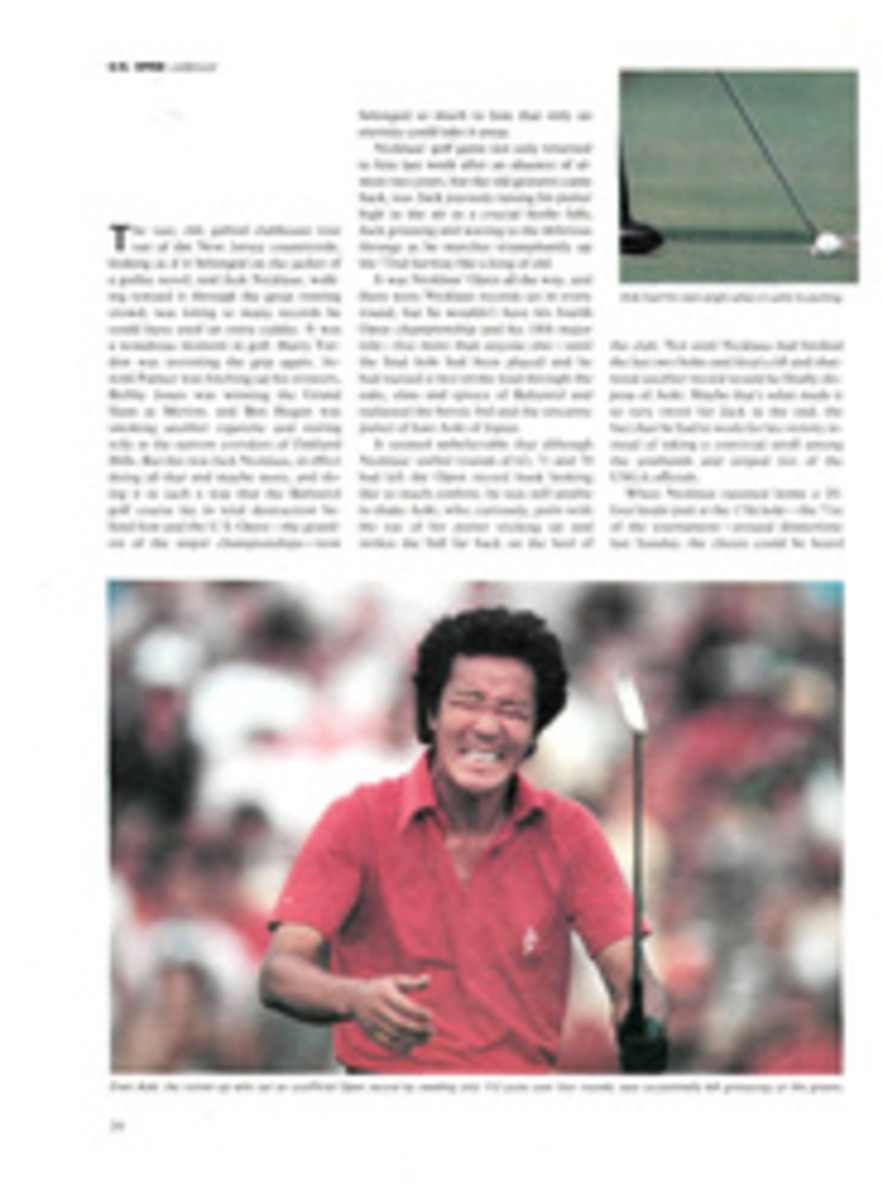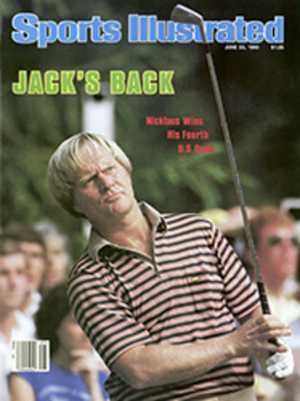
HEY, JUST LOOK WHO'S LOOKING GOOD AGAIN
During the final seconds before the running of the high hurdles at last week's national track and field championship in Walnut, Calif., Renaldo (Skeets) Nehemiah crouched at the starting line, head down, eyes fastened on Mount San Antonio College's sun-bleached maroon track. Not once did he look up to survey the 10 hurdles and 110 meters of straight that lay ahead. Nehemiah knows the course as well as any man alive. Last season he won the NCAA, AAU, Pan American Games and World Cup titles in this event. Along the way he produced the four fastest times in history, lowering the world record from 13.21 to 13-flat. Yet now, in that tense, seemingly unending pause before the gunshot that would start the race, Nehemiah was in unfamiliar territory. After an injury-plagued and turmoil-filled first half of 1980, he was facing the task of proving himself all over again.
Nehemiah's appearance in Walnut was only his third of the outdoor season and his first since May 11, when he ran a 13.77 in a nationally telecast race in Los Angeles. He was beaten that day by three other hurdlers—Rod Milburn, Dedy Cooper and his top rival, Greg Foster, whom Nehemiah had defeated 11 straight times. Foster's winning time that day, of 13.27, still stands as the fastest in the world this year. In Nehemiah's only other outdoor race, eight days earlier in Houston, he had won in 13.32. "I figured I was ready after that," he says, "but midway through the race in Los Angeles I was way back and fading, and I knew the truth. I was out of shape."
Nehemiah's ills actually started back in 1979, when he wore himself out competing almost every weekend between January and August. Exhausted, he came down with pneumonia in October. Then, in January of this year, two days after his only race of the indoor season, he tore a cartilage in his left ankle in a pickup basketball game. He was in a cast for six weeks, and soreness hampered his workouts long thereafter.
To complicate matters, Nehemiah was making as much news off the track as he ever had on it. Rumors abounded that Skeets had struck a lucrative deal with a sporting-goods company. Puma; such speculation seemed to be confirmed in April when Nehemiah quit the University of Maryland track team, thereby giving up his athletic scholarship. Under new guidelines set down by the International Amateur Athletics Federation, track and field's worldwide governing body, it is now possible for an athlete to remain an amateur while working for a corporation that uses his name in its advertising. However, the money paid the athlete for ads must go to his national governing body for track and field. In this country, that's The Athletics Congress, the recent successor to the AAU. In turn, the athlete can keep any money paid him for other work, such as consultation on shoe design. However, the NCAA takes a more puritanical stance on this matter, ruling that an athlete loses his collegiate eligibility when he signs such a deal. That's understandable. After all, the NCAA doesn't get any scratch out of the arrangement. Thus: Hello, Puma. Adios, Maryland.
Even though Nehemiah's deal with Puma hasn't been finalized, he apparently plans to take his new duties seriously. He showed up in Walnut dressed in Puma from head to toe. For Friday's heats and semifinals, his ensemble consisted of a striking navy blue warmup suit set off by jaunty red trim and shoes, while for Saturday's finals, he wore a natty red number with sparkling white trim and matching shoes. On both suits, the name SKEETS was tastefully printed on the left breast, above the Puma logo. The only accessory Nehemiah wore was a gold chain around his neck with a simple pendant that said—you got it—PUMA.
Of course, Skeets knows he will have to be more than a clotheshorse, and he had no doubt divined that the folks at Puma don't get all that worked up over hurdlers who finish fourth in 13.77. So in the weeks after the L.A. disaster, he had labored hard to ensure that he'd be as captivating as a hurdler as he would be as a model in Walnut. In fact, he had gone into seclusion, returning to his parents' home in Scotch Plains, N.J. to train with his high school coach, Jean Poquette.
Poquette had put Nehemiah through hard two-a-day workouts to rebuild his strength. Equally important, he had sheltered Nehemiah from the media, guarding against more of the sort of negative publicity that the Puma-Maryland matter had attracted. Indeed, when the issue was mentioned in Walnut, Poquette quickly said, "It's getting as tiresome as Farrah Fawcett's face got to be. The divorce is final." Poquette had also uncovered a flaw in Nehemiah's heretofore perfect hurdling form. Nehemiah's lead leg over the hurdles is his right, and he had developed the habit of thrusting his right arm forward simultaneously, which caused him to yaw to the left. Poquette pointed to a photograph of Nehemiah on the cover of this year's national championship program, showing Skeets making this very mistake while winning last year's title, and then declared, "That's why I don't think 13-flat represents anywhere near his maximum potential."
It was also Poquette who sent Nehemiah to Dr. William Litterer, a chiropractor, when stabbing pains in his left Achilles tendon made it look as if he would have to miss the championship. Litterer discovered that the hurdler's pelvis was angled in such a way that his left Achilles had to stretch further than the right. After a series of adjustments the weekend before the meet, Nehemiah was training without pain and starting to feel optimistic about gaining his third straight national title.
While Nehemiah was trying to regain his reputation, 18-year-old Stanley Floyd was busy building one. Four weeks ago almost no one had heard of the 5'9¾", 160-pound Auburn freshman. Now he is suddenly the newest U.S. sprint sensation and a surprise favorite for the 100-meter dash at the Olympic Trials, which begin this week in Eugene, Ore.
Floyd was a miler at Dougherty High School in Albany, Ga. until the day in his sophomore year when he was timed in 9.9 while outrunning the school's sprint coach in a 100-yard fun run. The next year he ran a 9.3 from a standing start on a dirt track, and before he graduated he won 54 straight sprints. He was undefeated this spring at Auburn, but he didn't make a name for himself until the Quad Conference meet in Austin, Texas on May 24. There he set a world junior record by winning the 100 meters in 10.07.
That race gave Floyd the second-fastest qualifying time for the NCAA championship, which took place two weeks later on the same track. The top qualifier was James Sanford of USC, who had run the two fastest times in the world in 1980, 10.02 and 10.03. Floyd was timed in 10.10 as he upset Sanford by .02 of a second for the NCAA crown. In winning that title as a freshman, he duplicated the 1976 feat of a recent Auburn graduate, Harvey Glance. Glance has helped Floyd with his starts, a weak point because Floyd didn't even use blocks until his senior year in high school. "Stanley's in the same position I was in as a freshman," says Glance. "He feels no pressure now. He may not even know what's going on."
Last Saturday, however, Floyd knew what to do as he won the 100-meter national championship. This time he was clocked in 10.19, the same as James Gilkes of Guyana, but was awarded the win after a study of the photo. Sanford had stayed home to rest a sore leg for the Trials. When asked if he is looking forward to running against Sanford again in Eugene, Floyd answered, "They say he had an off day in Austin. But I'm undefeated. I think I'm the man to beat."
Like Sanford, Foster passed up the national championship, but in Saturday's hurdle finals, Nehemiah found himself facing Cooper and Milburn. Cooper had the fastest semifinal time, 13.54, and Nehemiah admitted that he feared Milburn, who was his boyhood idol—not to mention the 1972 Olympic gold medalist. Milburn has recently returned to amateur competition after a five-year absence, during which he took part in the short-lived pro tour and then was idle until he could regain his amateur status. Normally, Nehemiah comes to track meets early, but on this day he stayed at his hotel until an hour before the race, watching a Tarzan movie on television to pass the time. "This has been a weekend of mental anguish," he admitted.
Nehemiah was first out of the blocks and got to the No. 1 hurdle just ahead of Milburn. He grazed that one and five others but never lost his lead and won in 13.49. Cooper also clipped a number of barriers, but he finished strong for second, in 13.56, as Milburn faded to fourth, behind Anthony Campbell.
Nehemiah was disappointed with his time but elated to be a winner again. "Getting this over with is a big relief," he said. "I'm strong enough and the speed is there. Now I just need a little oil. In my other two races earlier this year I was afraid to exert myself. This time I decided to run like a madman. I got myself out in front, which is where I wanted to be. I'm used to the loneliness out there." Renaldo Nehemiah was back on familiar ground.
PHOTO
ANDY HAYT
Stanley Floyd: once a miler, now a dash champ.
PHOTO
ANDY HAYT
A pending contract with Puma and a coach's eye had Nehemiah in top sartorial and hurdling form.

